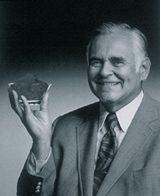Aspartame was discovered in 1965 by James M. Schlatter, a chemist working for G.D. Searle & Company.

Schlatter synthesized aspartame as an intermediate step in generating a tetrapeptide of the hormone gastrin.
Norwegian chemical engineer who helped develop aspartame sweetener as a sugar substitute while working for General Foods (1971-85), where she became a senior laboratory manager.
1975 - US FDA task force team
Prompted by issues regarding Flagyl and Aldactone, they reviewed 25 studies submitted by the manufacturer, including 11 on aspartame. The team reported "serious deficiencies in Searle's operations and practices"
1979 - CENTER FOR FOOD SAFETY AND APPLIED NUTRITION (CFSAN)
concluded, since many problems with the aspartame studies were minor and did not affect the conclusions, the studies could be used to assess aspartame's safety.
1980 - FDA convened a Public Board of Inquiry (PBOI) consisting of independent advisors
They were charged with examining the purported relationship between aspartame and brain cancer. they concluded aspartame does not cause brain damage, but recommended against approving aspartame at that time, citing unanswered questions about cancer in laboratory rats.
1983 - the FDA approved aspartame for use in carbonated beverages
and for use in other beverages, baked goods, and confections in 1993
1985 - Monsanto Company bought G.D. Searle
the aspartame business became a separate Monsanto subsidiary, the NutraSweet Company. Prior to its 1985 merger with Monsanto, Searle is a company focusing on life sciences, specifically pharmaceuticals, agriculture, and animal health. Searle is most notable for having developed the first female birth control pill and NutraSweet.
1996 - the FDA removed all restrictions from aspartame, allowing it to be used in all foods
Several European Union countries approved aspartame in the 1980s, with EU-wide approval in 1994.
Holland Sweetener Company
A joint venture of DSM and Tosoh, the Holland Sweetener Company manufactured aspartame using the enzymatic process developed by Toyo Soda (Tosoh) and sold as the brand Sanecta. Additionally, they developed a combination aspartame-acesulfame salt under the brand name Twinsweet. They left the sweetener industry in late 2006
2000 - Ajinomoto acquired NutraSweet and Euro-Aspartame from Monsanto
Ajinomoto is a Japanese multinational food and biotechnology corporation which produces seasonings, interlayer insulating materials for semiconductor packages for use in personal computers, cooking oils, frozen foods, beverages, sweeteners, amino acids, and pharmaceuticals. Aji-No-Moto (味の素, "essence of taste") is the trade name for the company's original monosodium glutamate (MSG) product, the first of its kind, since 1909.
2000 - Pharmacia Corporation was created by merging Pharmacia & Upjohn (which merged earlier?) with Monsanto and its Searle unit
The merged company was based in Peapack, New Jersey
Donald Rumsfeld (1932 – 2021)





